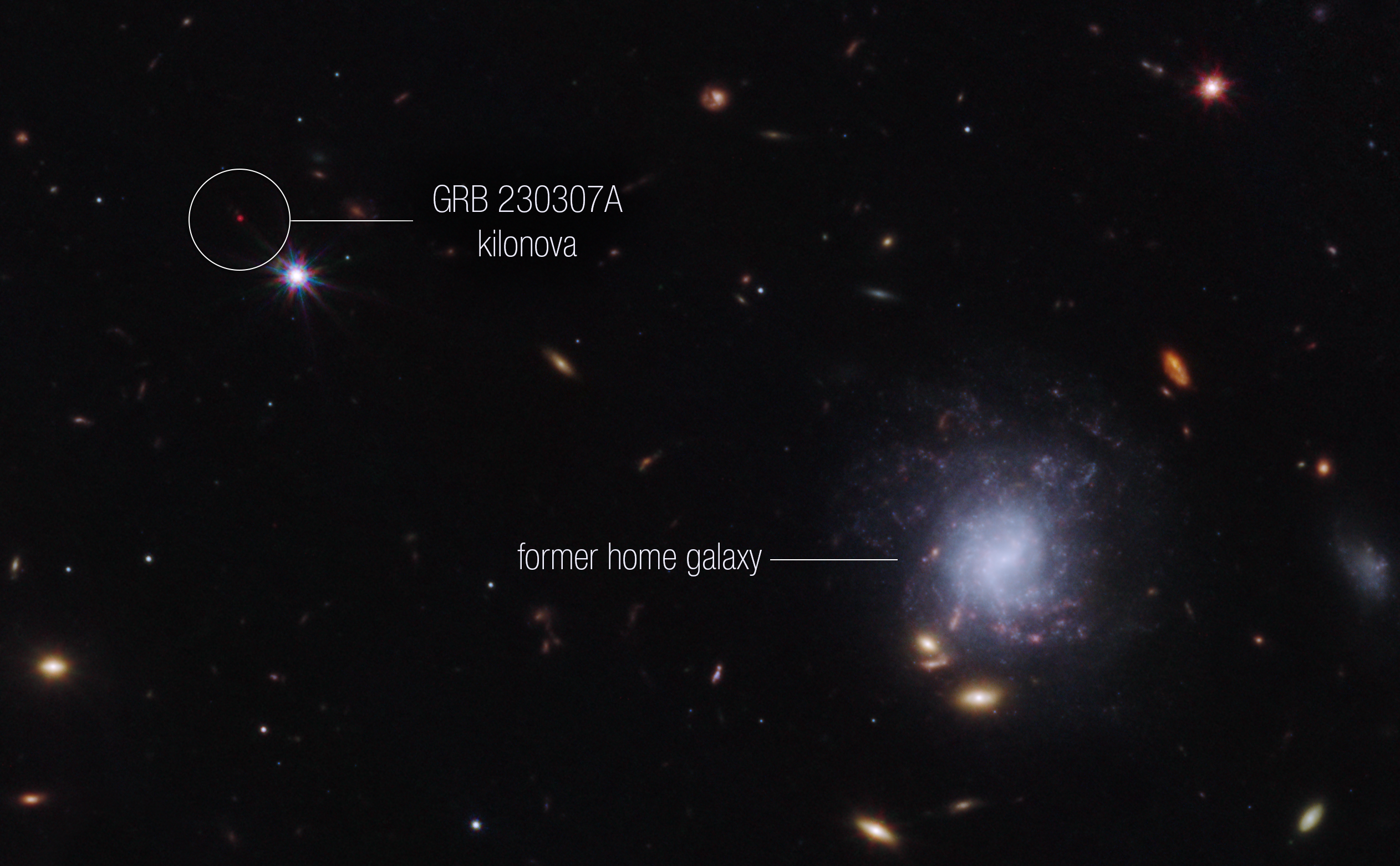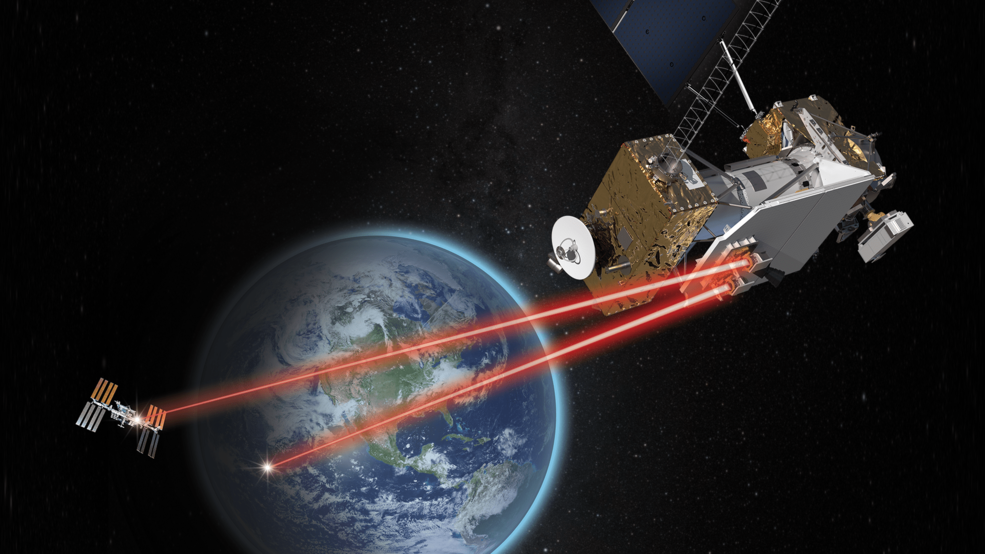2023-10-24 バーミンガム大学
 The stars travelled the approximate length of the Milky Way (about 120,000 light-years) outside of their home galaxy, before merging. Credit: NASA, ESA, CSA, STScI, Andrew Levan (IMAPP, Warw).
The stars travelled the approximate length of the Milky Way (about 120,000 light-years) outside of their home galaxy, before merging. Credit: NASA, ESA, CSA, STScI, Andrew Levan (IMAPP, Warw).
◆研究によれば、テルルといった重い元素がこの爆発の結果として検出され、地球上の生命維持に必要なヨウ素やトリウムなども含まれている可能性が示唆されています。この発見は、キロノバとして知られるこの種の爆発を研究する上で非常に重要であり、宇宙の生成過程について新たな理解をもたらすものです。この研究により、宇宙の仕組みと重要な元素生成のメカニズムについての知識が進展しました。
<関連情報>
- https://www.birmingham.ac.uk/news/2023/massive-space-explosion-observed-creating-elements-needed-for-life
- https://www.nature.com/articles/s41586-023-06759-1
JWSTが観測したコンパクト天体の合体による重元素生成 Heavy element production in a compact object merger observed by JWST
Andrew Levan,Benjamin P. Gompertz,Om Sharan Salafia,Mattia Bulla,Eric Burns,Kenta Hotokezaka,Luca Izzo,Gavin P. Lamb,Daniele B. Malesani,Samantha R. Oates,Maria Edvige Ravasio,Alicia Rouco Escorial,Benjamin Schneider,Nikhil Sarin,Steve Schulze,Nial R. Tanvir,Kendall Ackley,Gemma Anderson,Gabriel B. Brammer,Lise Christensen,Vikram S. Dhillon,Phil A. Evans,Michael Fausnaugh,Wen-fai Fong,Andrew S. Fruchter,Chris Fryer,Johan P. U. Fynbo,Nicola Gaspari,Kasper E. Heintz,Jens Hjorth,Jamie A. Kennea,Mark R. Kennedy,Tanmoy Laskar,Giorgos Leloudas,Ilya Mandel,Antonio Martin-Carrillo,Brian D. Metzger,Matt Nicholl,Anya Nugent,Jesse T. Palmerio,Giovanna Pugliese,Jillian Rastinejad,Lauren Rhodes,Andrea Rossi,Andrea Saccardi,Stephen J. Smartt,Heloise F. Stevance,Aaron Tohuvavohu,Alexander van der Horst,Susanna D. Vergani,Darach Watson,Thomas Barclay,Kornpob Bhirombhakdi,Elmé Breedt,Alice A. Breeveld,Alexander J. Brown,Sergio Campana,Ashley A. Chrimes,Paolo D’Avanzo,Valerio D’Elia,Massimiliano De Pasquale,Martin J. Dyer,Duncan K. Galloway,James A. Garbutt,Matthew J. Green,Dieter H. Hartmann,Páll Jakobsson,Paul Kerry,Chryssa Kouveliotou,Danial Langeroodi,Emeric Le Floc’h,James K. Leung,Stuart P. Littlefair,James Munday,Paul O’Brien,Steven G. Parsons,Ingrid Pelisoli,David I. Sahman,Ruben Salvaterra,Boris Sbarufatti,Danny Steeghs,Gianpiero Tagliaferri,Christina C. Thöne,Antonio de Ugarte Postigo & David Alexander Kann
Nature Published:25 October 2023
DOI:https://doi.org/10.1038/s41586-023-06759-1
We are providing an unedited version of this manuscript to give early access to its findings. Before final publication, the manuscript will undergo further editing. Please note there may be errors present which affect the content, and all legal disclaimers apply.
Abstract
The mergers of binary compact objects such as neutron stars and black holes are of central interest to several areas of astrophysics, including as the progenitors of gamma-ray bursts (GRBs)1, sources of high-frequency gravitational waves (GW)2 and likely production sites for heavy element nucleosynthesis via rapid neutron capture (the r-process)3. Here we present observations of the exceptionally bright gamma-ray burst GRB 230307A. We show that GRB 230307A belongs to the class of long-duration gamma-ray bursts associated with compact object mergers4–6, and contains a kilonova similar to AT2017gfo, associated with the gravitational-wave merger GW1708177–12. We obtained James Webb Space Telescope mid-infrared (mid-IR) imaging and spectroscopy 29 and 61 days after the burst. The spectroscopy shows an emission line at 2.15 microns which we interpret as tellurium (atomic mass A=130), and a very red source, emitting most of its light in the mid-IR due to the production of lanthanides. These observations demonstrate that nucleosynthesis in GRBs can create r-process elements across a broad atomic mass range and play a central role in heavy element nucleosynthesis across the Universe.



